
July 2023 | kcgmag.com GARDENER The Kansas City Homegrown Delicacies | In Praise of Female Birds Rose Report | Ask the Experts | Gray Hairstreak Butterflies Memorable plants from a Midwest spring garden
Independently owned and operated since 1996
PUBLISHER
Michael Cavanaugh
EDITOR
Elizabeth Cavanaugh
CONTRIBUTORS
Mr. Gardener
Lenora Larson
Dennis Patton
Judy Penner
Tamra Reall
Elizabeth Stoakes
Denise Sullivan
Scott Woodbury
DISTRIBUTION Publishers Delivery Solutions, Inc.

IF YOU WOULD LIKE TO DISTRIBUTE the magazine at your place of business, please contact Mike Cavanaugh at mike@kcgmag.com
913-648-4728
NEED MORE MAGAZINES? mike@kcgmag.com
913-648-4728
CONTACT US P.O. Box 8725 Prairie Village, KS 66208

913-648-4728
ADVERTISING
Mike Cavanaugh at mike@kcgmag.com
913-648-4728
EDITORIAL
Elizabeth Cavanaugh elizabeth@kcgmag.com
913-648-4728
HOW TO SUBSCRIBE
See details on page 17.
SUBSCRIPTION
Elizabeth Cavanaugh elizabeth@kcgmag.com


913-648-4728
WEBSITE
Garden Joy
“I grow plants for many reasons: to please my eye or to please my soul, to challenge the elements or to challenge my patience, for novelty or for nostalgia, but mostly for the joy in seeing them grow.
~David Hobson, garden writer and humorist
Countless times they ask me, “How is your garden?”
Whether at the grocery store or hair salon, the post office or car wash, it seems the common thread of conversation this spring has been about gardening. My response typically is, “better than expected.” The truth of the matter is that I’m impressed more than ever before. As the garden matures, I realize it grows into the garden I had imagined.
Sometimes we surprise ourselves, like in this email message I received. “I actually managed to get ALL the plants I grew and acquired this year in the ground this spring. I’m so proud of that—it doesn’t happen every year! Now, hopefully everything will grow!” You can feel the joy in those words. I believe all gardeners can relate to that sense of accomplishment. Whether just a few plants, or more than you can plant in one day, getting them all in the ground and potted is every gardener’s holy grail.
As we head into summer, and drought has gardeners praying for rain, I’m reminded that several inches of mulch does a world of
good. It holds the moisture in and keeps the soil cooler, resulting in healthier and happier plants.
We’ve planted all we’re going to plant in our landscape. Now the goal is survival. Mulching well and watering when needed are keys to success.
Another friend keeps telling me how amazing his turf looks. “It should be on the cover of your magazine. Just drive by and take a look.” The pursuit of landscape perfection takes quite a commitment. Surprising are the lengths we’ll go to make it happen. While I’m not an aficionado of turf growing techniques, I certainly can relate to the attentiveness of such an undertaking. I also can appreciate that feeling you get when discussing your successful vegetable garden or turf or a garden full of cut flowers. I guess that’s why they call it the victory garden.
The joy of life can be found in all that we encounter, from monumental accomplishments to everyday tasks. You don’t have to go far and you don’t have to look too hard. Take a walk. Visit your neighbor’s garden and listen. Listen to the joy
in their words as they describe their garden life. Discover the joy that lies waiting in you. Identify the things that bring you joy, that enrich your life, and then share that joy with others. And your garden is the perfect place to start.
I’ll see you in the garden!
editor’s
notes
GARDENER The Kansas City
kcgmag.com 2 July 2023 | kcgmag.com About the cover: Like chatting across the garden gate, Mr. Gardener talks about the plants that he favors, like the Zowie!™ Zinnia. See more starting on page 10. In this issue
kcgmag.com 4 Ask the Experts 6 Kids Ask Dr. Bug 7 Rose Report 8 Homegrown Delicacies 10 Memorable plants Midwest garden 12 In Praise of Female Birds
Plants on Your Plate: Tomatoes
Coming or Going: Gray Hairstreaks
Upcoming Garden Events
Garden Calendar
Subscribe
Hotlines
July 2023 |
14
15
16
18
17
17

The Kansas City Gardener | July 2023 3
SCANT FOLIAGE ON MAPLE TREE
Question: I have a 10-year-old red maple tree. This spring I noticed the leaf canopy at the top of the tree did not leaf out as fully. It also had many seed pods. What’s going on with my tree? Will it recover?
Answer: You are not alone as many maples suffered from this issue. The problem is the ongoing drought. The trees have been under a great deal of stress. As a result, they put on less growth which explains the weak leaf out this spring. When plants are stressed, they often have a higher fruit set. The fruit is the tree’s way of preserving the species as it is the seeds for the next generation.
The tree was telling you, “I am stressed and need help.” Even though the tree is established does not mean it will not suffer. Lingering drought issues have been with us for some time. The recommendation is to offer supplemental water and deeply soak the tree monthly if we do not have consistent soaking rains to offset the drought dating back to the summer of 2022.
DROUGHT WREAKS HAVOC ON ARBORVITAE


Question: I have noticed several evergreen trees which have died. Arborvitae were hit hard. What disease is happening, and should I be worried as I have a couple in my yard?
Answer: I sound like a broken record. This is drought stress. Evergreens are usually the hardest hit and first to show the signs of the ongoing dry conditions. No evergreen is native to the KC area. The past year to 18 months has seen wild swings in weather from excess moisture to the lingering drought.
Many evergreens are shallowrooted. Drought, combined with summer heat, is not a good combination. As a result, the trees have died. What can you do? Head off the effects of the drought before the plant turns brown. Once it is brown, it is way too late. Like my answer
Ask the Experts
to the maple question above, water deeply to soak the root system. Unfortunately, if it is brown, you must cut it down.
MAGNOLIA CYCLES THROUGH NOTICEABLE LEAF DROP

Question: I need help with my Brackens Brown Beauty Magnolia. This spring, it dropped so many brown leaves that I thought it was dead. The tree is an evergreen, so why did it drop the leaves, and should I cut it down?
drop just before the emergence of new growth. The drop does not mean the tree is dying. It could signal stress.
It is only necessary to cut the tree down if you cannot deal with the messy nature of the tree. If you like the tree, you must learn to live with the seasonal drop. You cannot prevent it; deal with it.
On the flip side, several Brackens did die. All the leaves turned brown and usually hung on the tree and did not drop. The main rea-
Plants that flower often set seed. Even though we plant potatoes from pieces of potato, it does not mean the plant does not flower or fruit.
The fruit looks a lot like a small tomato. Potatoes and tomatoes are plant cousins. Thus, the fruit is similar. A NOTE OF CAUTION— Please do not eat the fruit of the potato as it contains toxic compounds. These plants are members of the nightshade family, many of which are poisonous.
Answer: I received several questions about this magnolia this spring. I have this tree in my garden, so I fully understand your concerns. Brackens is an evergreen tree, but like all evergreens, this does not mean they hold their leaves or needles “forever.” Most evergreen plants keep their foliage for one to two years, then naturally fall off or drop. This is often referred to as a seasonal drop. This can happen in either fall or spring, depending on the growth cycle. Sometimes it is very heavy and noticeable. Other times not as much.
This past spring was one of the more noticeable leaf drops for Brackens. They dropped numerous older leaves all at once, creating a stir. The other issue is that the foliage is so large and coarse that it is very noticeable lying on the ground. This tree also has a yearly
son for the death? You probably guessed from reading this Q-and-A section. The issue is the drought. Like many plants, this one does not tolerate long periods of drought.
POTATO SETS FLOWER
Question: I noticed that my potato plants have flowers and even a few round green fruits. Is it common for potatoes to flower and set fruit?
Answer: Potatoes will often set a flower. Some people think it is a sign to harvest or that a plant must flower for a good harvest. Flowering has nothing to do with the quality of the harvest of the potato tubers. Flowering is a natural process of the plant life cycle. Harvesting the tubers is based on the vine growth. When the vines are about half yellow, the potatoes are mature and can be dug.
HOW TO CARE FOR INHERITED ASPARAGUS

Question: I moved into a home that had a planting of asparagus. I harvested earlier this spring. What do I do with the asparagus planting now that summer has arrived?
Answer: Asparagus is a lowmaintenance crop. During the summer and fall, we allow the fern growth to grow. The green makes energy for the plant and next year’s harvest. During the summer, control weeds, water, and wait. Once the foliage browns in the fall, it can be cut down. A light application of fertilizer will promote more growth. The more energy the plant makes during the summer, the bigger and better the next season’s harvest. The common mistake people make with asparagus is cutting the foliage off during the summer.
4 July 2023 | kcgmag.com
Arborvitae suffer drought stress. Brackens
Brown Beauty Magnolia. Asparagus is low maintenance.
DENNIS PATTON Horticulture Agent Dennis Patton is the horticulture agent for Johnson County K-State Research and Extension. For free information fact sheets, visit www.johnson.ksu.edu, or call the Extension office at 913-715-7000.





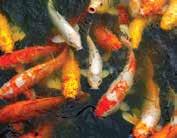














The Kansas City Gardener | July 2023 5 Check our website and Facebook for more THE METRO’S ONLY FULLY STOCKED, DEDICATED POND STORE! With the most diverse selection of equipment and livestock, we have products for all levels of pond hobbyists and the knowledge and experience to help you create and maintain your pond paradise! 816-842-5012 • pondskc.com 1557 Swift Ave., KCMO We have the friendliest, knowledgeable staff and serve the entire Kansas City metro! Welcome Lawrence Hobbyists! CONTRACTORS and INSTALLERS: Contact us for your equipment needs, pumps, Weir skimmers, wholesale pricing on select items. NEW KC Pond Bacteria Lower price vs National Brands Japanese Koi and Domestic Koi IN STOCK MERRIAM MARKETPLACE 5740 Merriam Drive, Merriam, KS SATURDAYS MAY – SEPTEMBER 7 a m TO 1 p m ▶ Beautiful pavilion with park and trail access ▶ Free and convenient parking ▶ Restrooms # Select from hundreds of different bare root daylilies with pictures and descriptions # Planting Corner with demonstration, tips, and educational materials # Bargain Table # All plants are from members’ gardens # Payment by credit card and cash Save the Date! Mo-Kan Daylily Society Plant Sale Sat., August 26 # 8:30 a.m. – 3:30 p.m. or until sold out Loose Park Garden Center, 51st St. and Wornall Rd., Kansas City, MO Mowing • Trimming Planting • Mulching Seeding • Aeration Fertilization • Clean Up Barclay Berberian 913-208-5941 LawnsByBarclay.com Design/Build • LED Lighting Pond Cleaning Services • Maintenence Repair - Leak Diagnosis • Winterization 816-560-0816 LoyalPond.com LoyalPond@gmail.com Our passion is water and providing an enjoyable outdoor oasis for our customers. (913) 703-7229 • 925 Southwest Blvd, KC KS Open 8a-6p Tues-Sat • And 8a-2p Sun Across from Strasser Hardware • @threebeesKCK Talavera Pottery Handmade Tamales Coffee and Specialty Drinks For Home and Garden... Euston Hardware 6955 Tomahawk Rd Prairie Village, KS 66208 (913) 262-1405 Euston Hardware 453 E Red Bridge Rd Kansas City, MO 64131 (816) 216-7197 Packs Hardware 116 N 169 Highway Smithville, MO 64089 (816) 532-0525 EUSTON
PACK’S
Kids Ask Dr. Bug about the curious things found in the garden
This question reminds me of a joke: What is worse than finding a worm in your apple? Finding half a worm! The worms in apples are actually caterpillars, often from the codling moth. When adult codling moths lay their eggs on the leaves or developing fruit of apple trees, tiny caterpillars hatch from those eggs and these hungry little caterpillars make their way to the center of the apple to feast on the apple core. The caterpillars feed for about three weeks before heading back out to hide in the bark of the tree and become a pupa so they can develop into an adult.
Not all apples have worms in them! Farmers work really hard to protect apples from these caterpillars. They use various methods to prevent the moths from laying eggs, like setting up special traps, using preventative sprays on the apples, or encouraging natural enemies, such as birds and parasitic wasps that kill the moths. The apples in stores and farmers markets go through careful inspections before they reach you, to make sure that you can enjoy worm-free apples.
Is a wasp sting worse than a bee sting?
Both wasp stings and bee stings can hurt, but the pain might feel a little different. Some people say that wasp stings can be more intense and sharper, while bee stings might feel more like a strong pinch. This might also depend on the species of the wasp and bee. Each species has different ingredients in their stinger recipes, and this affects how much it hurts, as well as how long it hurts and how it affects our bodies.
An entomologist (a scientist who studies insects) named Dr. Justin Schmidt created the Schmidt Sting Pain Index to measure how painful the stings of 83 species of stinging insects compare to one
another on a scale of 1 (mild) to 4 (severe). Sweat bee stings are barely a 1, Western honey bee and yellow jackets were both rated as a 2, whereas the tarantula hawk wasp sting was rated as a 4. You can learn more here: https://youtu.be/ B3puIOg0xE8 and https://youtu. be/CUjRKwr5qps (or scan the QR codes).
Careful! The tarantula hawk wasp has a sting rating of 4 out of 4.

It’s important to note that bees and wasps don’t seek you out to sting you, but you can unintentionally irritate them and get stung. Also, wasps can sting you multiple times, while honey bees can only sting once. So, please be careful outside – stay calm and avoid bothering bees and wasps. If you do get stung, watch for allergic reactions, such as hives, swelling or trouble breathing. If you or someone you know gets stung and has trouble breathing or feels very sick, it’s important to tell an adult right away, as they might need to get some help from a doctor.
How far can insects jump?
Some insects have remarkable jumping abilities! The distance they can jump varies among different species, if they can jump at all. Let’s explore some of the impressive jumpers.
Fleas are renowned for their incredible jumping skills. These tiny insects can jump up to 200 times their own body length (20 cm/8 inches height as a 1mm insect). That’s like a person nearly jumping
over the Empire State Building in a single bound! Grasshoppers are also known for their remarkable jumping abilities. With their long hind legs built for leaping, they can cover distances up to 20 times their body length. That’s like a human jumping the length of a football field!
Another insect, the froghopper, also known as the spittle bug, is the winner when it comes to jumping, though. This extraordinary jumper can propel itself vertically with astonishing force, reaching heights up to 70 cm (28 inches). To accomplish this impressive feat, the froghoppers hind legs are specialized and only used for jumping. When just walking, the hind legs are simply dragged along although they are ready to jump at a moment’s notice.
Next time you see a grasshopper springing through the grass or a flea or froghopper leaping through the air, take a moment to appreciate their incredible jumping abilities.
What is the fastest insect?
“Fastest” can be measured in many ways: fastest runner, fastest flyer, fastest wing beats. Scientists can measure “fastest” in absolute terms such as miles per hour or in relative terms such as body lengths per second. Not all insects have had their speed measured, and sometimes different life stages move
faster than others. There is still a lot to learn about insects! Below are the documented record holders, so far.
Fastest runner (absolute): Australian tiger beetles running almost 6 miles per hour.
Fastest runner (relative): Cockroaches moving 50 body lengths per second.
Fastest flyer (ground speed): Black cutworm moth flying at speeds of 60-70 miles per hour.
Fastest flyer (air speed): Hawk moths and possibly desert locusts flying average airspeeds of 33 miles per hour.
Fastest wing beats: No-see-ums beating their wings 1,046 times per second.
There are likely other insects that fly and crawl faster, but their speeds have not been accurately measured yet. For example, it is claimed that dragonflies can fly as fast as 60 miles per hour and horse flies at 90 miles per hour, but these speeds have not been proven. Wow!
Do you have questions for Dr. Bug? Send them to ReallT@Missouri. edu or https://bit.ly/KidsAskDrBug. Please include your name and age. To help me learn what you learn from this column, consider filling out this survey: https://bit.ly/ KidsAskDrBugSurvey.



6 July 2023 | kcgmag.com
TAMRA REALL Horticulture Specialist
Dr. Tamra Reall (@MUExtBugN Garden) is the horticulture specialist for MU Extension in Jackson County. For free, research-based gardening tips, call 816-833-TREE (8733), email mggkc.hotline@gmail.com, or visit www.extension2.missouri.edu.
Photo credit: By Xpda CC BY-SA 4.0
Left, Dr. Justin Schmidt
Right, Schmidt Sting Pain Index
Why do worms eat apples?
Kansas City summers can be brutal on roses. The combination of heat and humidity can quickly increase blackspot disease. Japanese beetles begin causing damage in June. And, as the temperature rises, the size of the blooms becomes smaller and declines quickly in the summer heat.
All of this sounds discouraging, but I want to encourage you to hang in there during July. The care you give the roses during that time will greatly reward you later in the year.
Here is my list to help you succeed with roses in July.
Supply roses with 1 to 2 inches of water a week. (If you aren’t sure on how much an inch of water using a watering wand, fill a 5-gallon bucket to the top and time how long
Rose Report
it takes to fill. That amount of time is equivalent to an inch of water.) The goal is to get the water deep into the rose’s root system.
Make sure there is 2 to 4 inches of mulch on your beds. This will keep the rose bed consistently moist. Mulch can also keep the soil 10-15 degrees cooler as well as reducing weed growth.
Reduce stressors like: Water in the morning so leaves dry off before evening. Watering in the evening keeps leaves wet, resulting in a hospitable environment for disease.
Fertilize using the proper and the correct amount of fertilizer.
Locate roses where they will receive 6 hours of sun. Less than 6 hours of sun weakens the rose, making it scrawny and susceptible to
disease. Placing roses in an area that gets afternoon shade is ideal, cooling them off from the oppressive summer sun.
Properly spaced roses allow air circulation around the roses. If
roses are planted too close together, the lack of air circulation will keep leaves moist, creating a breeding ground for disease.
Remove diseased leaves, canes and weeds from rose beds. This goes a long way in keeping your roses healthy.

If you are going to spray roses for disease, water the day before, and apply the spray in the morning when temperatures are cooler and when beneficial insect activity is lower.

I will end with a quote. Do not watch the petals fall from the rose with sadness, know that like life, things sometimes must fade to bloom again. ~Anonymous
If you have questions, please contact our Ask a Rosarian hotline at kcrosehelp@gmail.com.
The Greater Kansas City Water Garden Society Presents Lotus Entertain You 30th Anniversary Tour 2023


The 2023 Season of Tours are on the following Saturdays from 9 a.m. to 5 p.m. — Rain or Shine
July 8, Missouri, north of the river
July 15, Kansas, Leavenworth, Wyandotte, and North Johnson counties
July 29, KCMO inside the I-435 Loop, Raytown, and Independence
Aug 19, South MO, Jackson, south of the I-435 Loop, Ray, and Cass counties
Aug 26, South KS, South Johnson, Douglas, Miami, and Franklin counties

Tickets for all 5 tours are $10. Good for all tour dates and locations. Children under 14 attend free. Purchase tickets through Eventbrite by scanning the QR code, or visit kcwatergardens.com/2023-tour.

Westlake, 15225 W 87th Pkwy
LIBERTY Family Tree Nursery, 830 W Liberty
LOUISBURG Swan’s Water Gardens, 4385 W 247th St
N KANSAS CITY, MO KC Pond, 1557 Swift
OLATHE Hen House, 13600 S Blackbob Rd
Westlake, 120 N Clairborne
OVERLAND PARK
Family Tree Nursery, 8424 Farley
Hen House, 11930 College Blvd
Suburban Lawn & Garden, 10501 Roe Ave
Westlake,
Suburban Lawn & Garden, 9275 Dunraven St
Hen House, 6900 W 135th St

The Kansas City Gardener | July 2023 7
BLUE SPRINGS Westlake, 1205 MO Hwy 7 BONNER SPRINGS Westlake, 626 S 130th St FAIRWAY Hen House, 2724 W 53rd St GLADSTONE Westlake, 5945 NE Antioch Rd KANSAS CITY, KS Hen House, 8120 Parallel Pkwy KANSAS CITY, MO Planter’s Seed Company, 513 E Walnut Soil Service Garden Center, 7130 Troost Suburban Lawn & Garden, 4 W 135th St Sutherlands Lumber, 311 W 72nd St Westlake, 1000 Westport Rd Westlake, 5009 NE Vivion Rd LEAVENWORTH Westlake, 3400 S 4th St Trafficway A LEAWOOD Hen House, 11721 Roe Ave LEE’S SUMMIT Randy’s Lakeview Nursery, 1820 NE County Park Rd Westlake, 103 S M-291 Hwy Westlake, 444 SW Ward Rd LENEXA Hen House, 15000 W 87th Pkwy
9301 Santa Fe Dr Westlake, 11200 Antioch Rd PARKVILLE Westlake, 9200 MO Hwy 45 PRAIRIE VILLAGE Hen House, 4050 W 83rd St Hen House, 6950 Mission Ln SHAWNEE Earl May Garden Center, 21700 Midland Dr Family Tree Nursery, 7036 Nieman Rd Westlake, 12230 W 63rd St SMITHVILLE Pack’s Hardware, 116 US Hwy 169 GET YOUR TICKETS AT THESE RETAILERS.
Updated NTDF Logos as of March 2023: If you need EPS (Encapsulated Postscript) versions, please contact NTDF@kcmo.org or 816-513-3214 Full Color Primary Full Color Reverse Black and White Black and White Reverse
JUDY PENNER Rose Garden Consultant
Judy Penner is an American Rose Society Consulting Rosarian and Professional Rosarian since 1987. She has a Rose Garden Consulting business and can be contacted at judyssecretgardens@gmail.com.
Photo by Judy Penner.
‘Fourth of July’ climbing rose
Homegrown Delicacies: Part One
Recently, I was walking in the woods with a customer, discussing woodland restoration, when she mentioned that people had been trespassing, and were seen leaving with bags of plants, likely destined for the kitchen. It didn’t take long to find what they were after. I’m not going to reveal what the plant was, other than to say that there are many native plants that are sought after by top-notch and tinkering chefs and even more people who are willing to risk fines, jail time, and perhaps a loaded shotgun to poach them. Harvesting plant parts from public property, if not expressly allowed, is against the law, as is trespassing on private property. The perfect solution: grow and harvest wild edible plants yourself.
Let’s start with herbal teas. Wild strawberry leaves and linden flowers are two favorites of mine, and both are super easy to grow. Native strawberry (Fragaria virginica) (not the non-native “strawberry” groundcover present in some lawns) is easy enough to harvest, if you can lean over to pick them from the ground without pulling a muscle in your back. Linden (Tilia spp.) requires reaching up or standing on a ladder. First order of business, be safe. Linden trees bloom in early summer. Their flowers are delicately fragrant, like jasmine, and are pollinated by moths at night and bees by day. For the best flavor, strawberry leaves and linden flowers should be dried before steeping in water at 180° for three minutes, either together or separately. Mmmm-mmm good!
Another favorite tea is sassafras (Sassafras albidum). A six-inch portion of half-inch diameter (or smaller) root is harvested, washed, and cut into 1/8th inch slices. The freshly harvested and chopped root smells like wintergreen or root
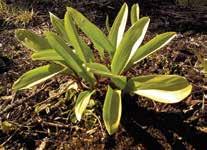
beer. Steep two tablespoons of chopped root in a quart of pure water, heated to 170°.
Another customer recently asked for stinging or wood nettle (Laportea canadensis)—the floodplain species that stings and itches

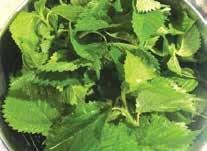
pinkish red skin and boiling in two separate pots of water to remove the nasty stuff that will give you a bad stomach ache. Both are tender and delicious early in the season.
My son used to grab and eat handfuls of wild garlic when he was
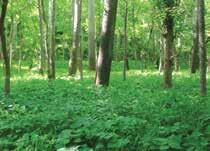
one—is the prettiest, with its purple or blue flowers. They should be your best friend in the garden, because they fill the gaps between other plants, creating stability in the garden; a blanket of protection against weeds. They are also host
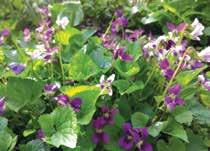
like crazy if you brush up against it on a walk wearing shorts. But there’s nothing tastier than steamed nettle leaves, dripping with butter, salt, and pepper, or added to a broth with arugula and stale bread (see Marcella Hazan’s The Classic Italian Cook Book). Surely somebody will start selling wood nettle plants at the local farmer’s market when people discover how tasty they are. Other yummy steamed green come from wild goldenglow (Rudbeckia laciniata) and pokeweed (Phytolacca americana).
Note that goldenglow is a mild laxative, and take caution when eating pokeweed. Pokeweed contains toxins and requires harvesting only very young shoots and leaves, stripping off the outer
SCOTT WOODBURY Horticulturist

little—you know, those weedy onions that show up in old fields and gardens. Have you ever tasted it? If you ask me, it’s pretty potent stuff with a harsh aftertaste. For more refined palettes, there are wild leeks (Allium tricoccum), which is available at some native plant nurseries. It takes a few years to grow a small patch, but it is well worth the effort. While waiting for the patch to grow, harvest only a few leaves at a time to flavor an omelette or salad. In a few years, you’ll be harvesting bulbs as well.
In the book Stalking the Wild Asparagus, author Euell Gibbons wrote that a half cup of chopped violet leaves has the Vitamin C content of five oranges. In spring and early summer, I love adding violet leaves and flowers to a salad. The leaves get tough by mid-season. Any species will do, but common violet (Viola sororia)—the weedy
plants for great spangled fritillary butterflies. I also like adding young, tender leaves of chickweed, plantain, strawberry, spiderwort, lamb’s quarter, and dandelion to a salad—what amazing texture and flavor this combination has! Top it all off with redbud flowers for a festive, delightful early-season salad.
A conversation about wild edible plants wouldn’t be complete without talking about berries and other fresh fruit. Look for my next article, “Homegrown Delicacies: Part Two,” where I will cover them in detail. In the meantime, know that there are many that you can easily grow in your garden, including serviceberry, elderberry, red mulberry, Missouri gooseberry, strawberry, golden currant, pawpaw, persimmon, and wild plum. Oh dear, my mouth is watering thinking about it.
Happy gardening y’all!
Note: These resources on native edibles are intended as general information only. As with any foods, there is a potential for allergic reactions when consuming native edibles. Always seek the advice of a health professional with any questions about touching or eating any plant matter.
Scott Woodbury was the horticulturist at Shaw Nature Reserve for 30 years and stepped down from that position in June 2022. He continues to work on contract for Shaw Nature Reserve to carry out native landscaping education and has launched his own business called Cacalia: Native Garden Design and Wilding. Find suppliers of native plants, seeds, and services at the Grow Native! Resource Guide: www.moprairie.org.

8 July 2023 | kcgmag.com
Wild Leeks
Common Violets Native Strawberry
Stinging Nettle
Nettles in steamer
Photo by Carol Davit.
Photo by Scott Woodbury.
Photo by Scott Woodbury.
Photo by Scott Woodbury.
Photo by Scott Woodbury.
Grow Naturally For Healthier Soil & Plants












The Kansas City Gardener | July 2023 9 LAKEVIEW NURSERY & STONE WE DELIVER! CALL TODAY! 816.525.1111 WWW.LAKEVIEWKC.COM 1820 NE COUNTY PARK RD, LEE’S SUMMIT Koi Pond and Water Feature Designs Wendy Hix • 913.481.5416 Tate Foster • 913.406.6804 www.hixandsonaquatics.com New Installations, Remodels Upgrades, Repairs and Maintenance Services Often Copied NEVER DUPLICATED Accept only Earth Right Products for the health & beauty of your lawn & garden.® Contact Tobin Lawn 816-765-5565, or Big Green Turf Management (816) 600-4936 to have our products applied for you. Visit the Laura Conyers Smith Rose Garden & see Earth Right products at work! EARTH RIGHT products help you beat the heat. Our conditioner is in all of the plant products. This helps wick water, keeping plants cooler. For bigger roots & lots of blooms use Mushroom Stuff™ & Sure Bloom™ on turf or in gardens. Keeps roots from burning & soil conditioned. Great in containers! Covers 20K sq ft. Covers 10K sq ft. Natural products that work!
www.superlawnstuff.com (913) 492-2992 Made in the Heartland
Memorable plants from a Midwest spring garden
Hello friends. Mr. Gardener here. I’m usually the behindthe-scenes guy with the magazine. Although this issue I wanted to share a few of my favorite plants from our garden that are high performers and get the neighbors talking. I’m intentionally leaving out botanical names. The tags are somewhere, but we rarely refer to them. The common names will suffice when asking for any of theses plants in your local garden center.

Zowie!™ Zinnia Yellow Flame
This was my favorite flower grown from seed in the greenhouse this spring. Very easy to grow. Zowie, I say Zowie wowie! I started them a little too early, so while waiting for warmer weather I had to repot them into bigger pots. Now planted in the perennial bed, these zinnias have reached 2 to 2 1/2 feet peeking above other plants. Thick sturdy stems and good branching support flowers that are 3 inches wide with several layers of petals that change colors as they mature. These showstoppers have attracted butterflies and birds. As monarchs bounce from flower to flower I’ve shouted more than once, “Butterfly on the Zinnia, Butterfly on the Zinnia!” It’s nice knowing we play a small part in the lives of these magnificent creatures. Great for cut flowers that last for weeks and rebloom quickly in the garden. They make me smile every time I walk the garden and are definitely on the list for next year.
Oakleaf Hydrangea
Planted on the north side of the house, these plants are close to 6 feet tall screening the back section of the house. Heavy with large
white blooms that spill into the pathway, I enjoy the lovely scent as I pass by. Interesting to note how these hydrangea have flourished with partial sun. One is tucked between the deck and back wall, and is the only plant that seems to perform well in this spot with limited sun exposure. The foliage shows brilliant crimson in the fall.
Zinnia Profusion
I’ve grown these from seed for several years now. And (again) I started too early resulting in blooms as early as April. I just can’t help myself. Zinnias make great cut flowers, so to add a little color to the Editor’s desk that early in the year is a plus. These compact plants work well in the garden and containers continuing to bloom until first frost. They prefer full sun but I do have a pot full in a somewhat shaded area that still flower nicely.
Tree Peonies
These deciduous woody shrubs bloom in early spring. The flowers are showy and fragrant. They receive dappled shade and require no pruning except for an occasional dead branch. Every spring I say to the Editor, “Sure seems early for the peonies to be budding!” She reminds me that they are right on time. Once they start it’s quite a show. We have several plants with a variety of colors. Along with tree peonies we have herbaceous and Itoh varieties that bloom soon after. Once established, all you have to do is enjoy the show.
Coreopsis

We added three coreopsis to the perennial garden last season. As sometimes happens, only one came
back. At the end of May, while strolling through the front garden I said, “Where the heck did that come from?” I was shocked how big, full and healthy this plant was and it seemed to pop up overnight. Of course, as any plant lover would say, “I need a few more of these plants!”
Salvia
An early spring bloomer in our garden. These perennials are about five years old, and they never fail to shine with deep blue flowers. Attracts butterflies and produces a lot of bee activity. Very low maintenance and drought tolerant. We cut back after blooming to encourage more flowers. There are several colors available and will perform best in a sunny location.
Hosta
By far, this is my preferred plant in the garden, mostly for its tropical appearance. The side garden shaded by a mature oak tree is the ideal location where I’ve planted many varieties, with different shapes, textures, and sizes. This is my weakness when at the garden center. When Elizabeth says, “And where are you going to plant that?” My reply is consistent, “There’s always room for another hosta.” Last fall I divided six of my ‘Guacamole’ hostas into 24 plants. Some went back to the original bed and the rest… well, I found a place… and all returned beautifully in spring. Raising four kids, we played a lot of basketball in the driveway under that big oak. When they visit I’m sure they still hear echoes of me shouting “Watch the hostas!” They all developed a great skill of navigating through the hosta land-
mine to chase the ball. I’m happy to report both hostas and kids are thriving.
‘Stella d’Oro’ Daylily
I love any daylily and this is always the first daylily to bloom in early summer. The arching grasslike leaves are full of golden yellow blossoms. Sixteen are planted in a double row along the street, adding color and texture to the front side garden. They stay compact and deadheading promotes reblooming. I see why they call this plant America’s favorite daylily.
Coleus
This plant is fun to grow from seed. It fills the greenhouse with much needed color until spring arrives. This year I grew a variety from the Kong Series. I’ve always planted them in containers for the deck and front steps where it is slightly shaded. Their upright mounding foliage quickly fills any container and lasts until first frost. A few were planted in a raised bed along the front steps. The dynamic color combinations brighten up the entryway to our home. Garden centers offer many varieties in every color. If you haven’t tried them, pot up a few. You’ll be hooked.
The garden usually has something blooming from early spring to late fall. We like sequential blooming where plants have their own unique showtime. Soon to begin their show are Coneflower, Black-eyed Susan, Stokes’ Aster and a wide assortment of colorful daylilies.
These plants work well in our landscape. Maybe they’ll work well in yours. So grab a shovel. There’s always room for one more plant.
10 July 2023 | kcgmag.com
Mike Cavanaugh is an avid plant lover and a true native Floridian. He owned a small tree nursery in central Florida for many years supplying trees to local landscapers. Inspired by the desire for a new adventure, he moved his wife, four kids and the family dog to the Midwest 28 years ago. When family and friends asked why, he replied “I’m going to start a gardening magazine.” And the adventure continues.
MIKE CAVANAUGH
Mr. Gardener
‘Stella d’Oro’ Daylilies








The Kansas City Gardener | July 2023 11
Zowie!™ Zinnia Yellow Flame
Above: Oakleaf Hydrangea
Below: Tree Peony
Above: Coleus
Below: Coreopsis
Salvia
Zinnia Profusion
Hosta
In Praise of Female Birds


Many birders trace their fascination with the feathered tribe to their first encounter with a vibrantly colored, singing spring male. Who can resist the serenade of a red Summer Tanager, a royal blue Indigo Bunting, or a lemon yellow and black goldfinch? But none of these amazing individuals would exist without the efforts of the (often overlooked) other half of the species. Let’s take a moment to appreciate the “superpowers” of female birds.
Females directly influence the characteristics and evolutionary destiny of their species by deciding which males will reproduce. Males invest much time and energy in attracting female attention, using courtship flights and displays, offerings of food and nesting material, and singing. Females generally select experienced males with the brightest plumage, best foraging skills, and the most polished, melodious songs (for some, such as mockingbirds, favored males possess the largest song repertoires).
A songbird’s breeding life is often limited to a few seasons, and some produce only one brood annually. Success means fledging as many healthy chicks as possible, and the female’s choices help determine the productivity of both partners. For example, during bluebird and House Wren courtship, males seek out nest sites and may begin multiple nests—but females ultimately choose their family’s home. Wise site selection, with maximum protection from the elements, reduced chances of predation, and proximity to plentiful food, gives chicks the best chance of survival. Just as males improve their singing and courting abilities with age, females increase their skills at site selection and nest building.
In many backyard birds, such as robins, goldfinches, House Finches, and titmice, the female shoulders all the work of nest building and incubating eggs. A nest takes several days to a week to prepare; materials
vary by species. Robins build a sturdy cup of grasses and twigs, with a mud foundation and a lining of soft plant materials. Goldfinches delay nesting until midsummer in order to pad their cup-shaped nests with thistledown. Female orioles spend 10 to 14 days weaving an intricate pouch from strands of grass and plant fibers—usually located near the end of a slender branch where it’s less accessible to predators.
Before incubation can begin, the female produces her clutch. A fully developed egg (produced in about 24 hours) may account for up to 12% of her body weight! Eggs are generally laid singly over several days. Meanwhile, she sheds feathers from her underside, exposing a portion of bare skin known as a “brood patch” that will keep her eggs (and later nestlings) warm. Average incubation time for small songbirds is 12-14 days. Then, several weeks of constant foraging and vigilance is required to raise the chicks to independence.
In species that produce multiple broods, such as cardinals, robins, and bluebirds, the female will often begin a second nest while her mate feeds fledglings from the first.
Both parents often work together to feed nestlings, but the female’s presence is vital during the chicks’ first week of life. Most songbirds are naked at hatching and cannot maintain their own body temperature. Research on bluebirds showed that if the female disappears when the chicks are fewer than 7 days old, they usually die. The male feeds them, but is unable to warm them adequately.
Males assist by defending nests and feeding mates, but nesting is undoubtedly the most vulnerable and perilous time in a female bird’s life. Subdued but attractive colors (like the dull greenish-yellow of a goldfinch or warm brown of an Indigo Bunting) and camouflage patterns (like the brown streaks of House Finches or Red-winged Blackbirds) help both the female
ELIZABETH STOAKES

Birding Enthusiast
and her nest to escape the notice of predators.
The miniscule Ruby-throated Hummingbird is a dynamic example of “girl power”. Following a strenuous spring migration from her winter home in Central America, she establishes and defends her own nesting territory, separate from the male. After mating, the male pursues other partners, leaving her alone to build her walnutsized nest. Ingeniously disguised with lichen and other plant material, and reinforced with spider silk, the nest expands as the chicks grow. (She sometimes reduces her workload by reusing and refurbishing a previous season’s nest.) She
incubates her two tiny eggs for 11 to 16 days, then feeds the young on insects (especially spiders) and nectar for approximately 3 weeks until they’re ready to fly. While investing tremendous energy in her offspring, she must also find time to forage and feed herself. She may raise TWO broods per year under ideal conditions—an amazing accomplishment!
This summer and fall, when newly fledged hummers and cardinals gorge themselves at your feeders and speckled young robins forage for worms on your lawn, I hope you’ll stop and marvel at the durable and determined female birds who raised them “behind the scenes”!
12 July 2023 | kcgmag.com
(Above) Elegant female Red-winged Blackbird
(Below) Dynamo: Female Ruby-throated Hummingbird
Photos by Terrence Thompson.
Elizabeth Stoakes is currently President of Burroughs Audubon Society in Kansas City and has been birding for over 25 years. Please contact BAS via mail@burroughs.org or text/call 816-795-8177 with any birding questions.






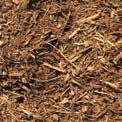









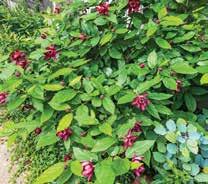

The Kansas City Gardener | July 2023 13 6979 WEST 75TH STREET OVERLAND PARK, KS HOURS: MON-SAT 10A-5P | CLOSED SUN 913•341•0700 WildBirdHouseStore.com Find us on Facebook! LARGEST SELECTION of wild bird supplies in the KC area, including bird seed, feeders, houses and hardware. 816•924•4924 4480 SOUTH NOLAND RD INDEPENDENCE, MO HOURS: TUES-SAT 10A-5P | CLOSED SUN Family-owned & operated since 1990. House Finch Providing Expert Advice without a Membership Price. Top Soil • Mulch • River Rock • Sand • Gravel Fireplace Materials • New & Used Brick • Pavers 9108 W. 57th Merriam, KS 66203 (1 blk E. of Merriam Dr.) Hrs: Mon.–Fri. 7am–4:30pm • Sat. 8am-12pm 913-432-8092 Northland Feed 4807 N. Brighton, KCMO • www.mowerpartskc.com 816-452-8393 • Mon.-Fri. 9-6 • Sat. 9-4 Serving the Northland for 45 years Mowers, Blowers, Hedge Clippers and Chain Saws are in stock now! All equipment assembled, serviced and ready to go when you buy it. We also carry Lawn & Garden supplies, pet supplies and bird seed. We service what we sell and more! Nothing goes out of here in a box! www.greenleafkc.com 816.916.5171 LET US HELP KEEP THE BEAUTY GOING • Update, clean • On-going bed maintenance • Gardens • Professional service FIND BACK ISSUES AT KCGMAG.COM GRAB A CUP OF COFFEE, SIT BACK AND ENJOY OUR ARCHIVES MISSED AN ISSUE? KCGMAG.COM
PLANTS ON YOUR PLATE Tomatoes
American urban markets and today is grown world-wide, where the temperate seasons allow. California, Florida, and Georgia lead tomato production in the U.S.
Tomatoes are rich in vitamin C, potassium, magnesium, and fiber. They are also one of the richest sources of lycopene, a phytonutrient that shows great promise in cancer prevention. It is worth

noting that the amount of lycopene increases when tomatoes are cooked, as in a sauce.
Whether cooked or fresh, there are numerous ways to enjoy tomatoes. This salad recipe is great as a quick meal and can be personalized with any of your favorite vegetables. It also gives a nod to the Mediterranean region who first accepted tomatoes.
Mediterranean Bowl
MAKES 1 SERVING
SALAD INGREDIENTS
1/3 cup cooked brown rice
1 cup fresh spinach, roughly chopped
½ cup diced cucumber
As I visit with gardening friends or farmers market shoppers, I often hear that people are anxiously awaiting the tomatoes. America’s most popular home garden plant happens to be my favorite (and most successful) crop as well. It doesn’t matter if it is fresh from the garden or prepared into a favorite sauce or salsa, the versatility of the tomato makes it easy to understand why it is America’s favorite.
Tomatoes belong to the Solanaceae family, more commonly known as the nightshade family. Other members of the Solanaceae family include peppers, potatoes, tomatillos, eggplant, and even tobacco. For centuries, the association with the nightshade family coupled with the strong scent given off by the plant, led to the myth that tomatoes were truly poisonous. Long before it was considered fit to eat, it was grown only as an ornamental garden plant, sometimes called “love apple.”
Tomatoes are native to the Andes of Peru, where they first grew in the wild as a bright red, marble-
sized, cherry-type tomato. Gradually, they would spread throughout South America and north into Central America but then the trail goes cold until Christopher Columbus’ travels to and from the ‘new world,’ which would eventually land the fruit in Spain in the mid16th century. Over the next several decades, different cultivars spread through Spain, France and Italy and became a widely accepted food in the Mediterranean region. As the tomato varieties spread north and east through Europe, they were not as widely accepted among the English and German and were often thought to be poisonous.
As the colonies established in the United States, the tomato became less feared. One of the earliest notable growers of tomatoes was Thomas Jefferson, who was a remarkably progressive Virginia farmer as well as a statesman, who grew them in the late 1780s. By the early 1800s, tomatoes had become a common enhancement in the Creole gumbos and jambalayas of Southern cooking. By 1850, the tomato had made its way into most
DENISE SULLIVAN Nutrition Ninja

½ cup cherry tomatoes, sliced in half
½ cup garbanzo beans, drained and rinsed
VINAIGRETTE INGREDIENTS
1 Tablespoon lemon juice
1 Tablespoon olive juice
1 teaspoon dried oregano
Salt and pepper
DIRECTIONS
• Wash hands and work surfaces with soap and water.
• Measure cooked brown rice and place into a medium size bowl.
• Wash and rinse spinach, cucumber, and cherry tomatoes. Chop or slice vegetables to your preference. Place on top of brown rice.
• Drain and rinse a can of garbanzo beans. Place ½ cup on top of brown rice and vegetable mixture.
• In a small bowl, combine vinaigrette ingredients. Whisk together with a fork. Drizzle all over brown rice, vegetables, and beans.
• Toss to combine. Add lemon slices as garnish if desired.
NUTRITION INFORMATION
Calories: 277, Total Fat: 16g, Saturated Fat: 2g, Sodium: 150mg, Carbohydrates: 31g, Fiber: 6g, Protein: 7g
Recipe adapted from medinsteadofmeds.com, analyzed by verywellfit.com.
Denise Sullivan (@MUExtJacksonCo) is a Nutrition and Health Education Specialist for MU Extension in the Urban West Region, serving Jackson and Platte Counties. For research based nutrition and food safety information and programs, call 816-482-5850 or visit https://extension2.missouri.edu/.
14 July 2023 | kcgmag.com
Coming or Going: Gray Hairstreaks

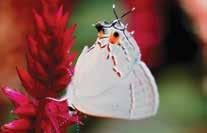
Which end is the head? To confuse potential diners, adult Hairstreak butterflies have slim tail hairs at the bottom of the hind wings that look like antennae, especially since the butterfly flicks them in a quivering motion. And both the top and under hind wings are marked with a distinctive orange “eye.” A predator, confused by this mimicry, may bite the tail-end and get a mouthful of dusty wing as the butterfly escapes with its head and abdomen intact.
Because Hairstreaks are not picky eaters, they have colonized many habitats throughout the new world, from southern Canada to northern areas of tropical South America. Our most common Hairstreak in the Kansas City area is the Gray, which has 3 broods each year so we see adults flying from April to October. They are relatively small with a wingspread from 3⁄4” to an inch, which is a shame since they are a spectacularly beautiful butterfly. The upper side of the wings shimmers in shades of blue caused
by refracted sunlight, not pigment. The underside is a uniform soft pearl-gray with that orange eye and a few black squiggles.
We also have occasional glimpses of the Juniper Hairstreak, the only green butterfly in the United States. Several sightings in my yard converted me to a butterfly aficionado in 1994. Its caterpillar dines on Eastern Red Cedar, which is a Juniper, Juniperus virginiana. The green and chestnut adults nectar on small-flowers like the Mountain Mints and Queen Ann’s Lace. If you head east to the Ozarks, you should also see the similar Coral, Banded and Red-banded Hairstreaks.
Life Cycle
The pale green eggs are laid singly on the host plant flower and hatch in 4 to 6 days. The long-lived caterpillars dine for 3 to 4 weeks and then pupate in the leaf litter, which is also their winter hideout. Leave those leaves! By mid-April the adult emerges to find love with

LENORA LARSON Butterfly Maven

the males perching on shrubs to ambush passing females. These males are avid puddlers, collecting minerals to include in their spermatophore, which is passed to the females when mating. The adults live up to ten days and prefer small blossoms for nectaring. I see them most frequently on my Celosia.
Feasting on Flowers
The small slug-like caterpillar looks velvety with short hairs covering its body. While most caterpillars eat leaves, the Gray Hairstreak caterpillar feasts on flowers. This is not a restricted diet with over 20 plant families, representing over 50 species, serving as host plants. In our area, the legume family seems to be its favorite and occasionally it even eats legume fruits such as pea and bean pods. I’ve also found the caterpillar munching on Lythrum and Rose Verbena flowers, which dye the caterpillar a lovely rose color. When dining on my purple pole beans they are a soft violet, and pale green when eating clover
blossoms. In the south the Gray Hairstreak caterpillar is called the Cotton Square Borer because it dines on young cotton bolls.
Myrmecophily

Occasionally the caterpillars are guarded by ants, which stroke them to release the sugary honeydew. This activity, called myrmecophily or “ant-loving,” can be cited as an example of animals practicing animal husbandry. That is, the ants keep herds of Gray Hairstreak caterpillars, grooming them, “milking” them, and protecting them from predators.
Summary
You don’t have to be big to be beautiful! Although Hairstreaks are huge compared to 50 percent of our native bees, which are smaller than a grain of rice! Since Gray Hairstreaks are so flexible in their habitat and feeding requirements, you are almost sure to see them in your garden and on butterfly hiking trips. Enjoy!
The Kansas City Gardener | July 2023 15
The dorsal view is a shimmering gray-blue.
When Gray Hairstreak caterpillars eat Lythrum flowers they turn rosy-red.
The caterpillar matches its green bean pod diet.
A Marais des Cygnes Master Gardener, Lenora is a member of the Idalia Butterfly Society and Kansas Native Plant Society. She gardens in the clay soil and cruel winds of Paola, KS. She may be contacted at lenora.longlips@gmail.com.
The adult nectars face down to make its false face prominent.
Photo by Lenora Larson.
Photo by Lenora Larson.
Photo by Lenora Larson.
Photo by James Maughn, CC BY-NC.
Upcoming Garden Events
Daylily Garden Open House
Jul 1-3. Open 9a-1p; at Hart’s Daylilies, 7460 W 255th, Louisburg, KS. Over 700 varieties on display. Call 913-837-5209 for additional information.
Raytown Garden Club
Tues, Jul 11, 10a; at Connection Point Church, 10500 E 350 Hwy, Raytown, MO 64138. Meeting rescheduled because of the Independence Day holiday. Program will be “Wonders of the Amazon; Cultivating Victoria Water Lilies” presented by Caitlin Bailey, Professional Horticulturist, KC Country Club. Guests are always welcome. For more information please check out our Facebook page: https:// www.facebook.com/RaytownGardenClub.
Leavenworth County Master Gardeners

Wed, Jul 12, 11a; at Riverfront Community Center, 123 Esplanade St, Leavenworth, KS 66048. Our speaker is Angela Turner of Bel Fiore Farm & Floral of Lee’s Summit, MO. Angela is a leading farmer florist (a floral designer who also grows flowers) in the Greater Kansas City area. Learn about the national movement towards locally grown flowers, behind the scenes of flower farming and Bel Fiore’s latest venture—a flower bar and boutique that aims to feature locally grown flowers. The meeting is free and visitors are welcome. For more information contact the Leavenworth County Extension office at 913-364-5700.
Food Preservation: Fresh from the Garden
Thurs, Jul 13 and Thurs, Jul 20, both 6-8p; at Johnson County Extension Office, 11811 S Sunset Dr, Olathe, KS 66061. Preserving your own food at home is a great way to savor food from your garden all year round. Johnson County
Extension will offer two classes on canning. July 13 will be Pressure Canning, and July 20 will be Water Bath Canning. Cost is $30 per class. Learn more at johnson.ksu. edu.
Flower Garden and Train Tour
Sat, Jul 15, 10a-5p; B & F Railroad and Flower Tour at 1503 Ensley Cir, Raymore, MO. The entire yard is full of beautiful flowers and we have 6 Garden Trains that run in the entire back yard. We also have a large koi water garden. This is one of the best Flower Gardens that you will ever see. This is a Free Event. No Pets, Please.
Olathe Garden & Civic Club
Tues, Jul 18, 1-2:30p; at 35230 W 135th St, Olathe, KS. *Free to attend–Must RSVP by July 10th–RSVP to Julie: jpickerill61@gmail. com. Please join us for our monthly club meeting and Master Gardener presentation, club membership not required, bring a lawn chair.
Holt County Garden Tour in Oregon and Forest City MO
Sat, Jul 22 (rain date Jul 23), 10a2p. Presented by MO Extension. Four uniquely different flower and vegetable gardens. For more information check Facebook MU Ext. in Holt County. 660-446-3724
Integrating Native Plants Into Your Home Landscape
Wed, Aug 2, 12p. Virtual. The KState Garden Hour Series will offer a one-hour online session about native plants, which have grown in popularity for the home landscape.
Dr. Sharon Ashworth, Douglas County Horticulture & Natural Resources Extension Agent, will discuss the ecological benefits of native plants and how to successfully integrate natives into your landscape. Learn about what defines a native plant, which native plants work best, and what maintenance is
required to grow a beautiful landscape of natives.
Kansas City Cactus and Succulent Society
No meeting in July due to the national cactus and succulent conference in Colorado Springs, CO. Mark your calendars for our special sale of plants and pottery Sat, Aug 5, at the Trailside Center, 99th & Holmes in Kansas City. Hours are 9a-3p.
Dahlia Shows
The Greater Kansas City Dahlia Society announces this year’s show schedule:
Missouri State Fair Aug 18-19; Powell Gardens Sep 1-2; Suburban Lawn and Garden Sep 29-30 (135 & Wornall Rd, KCMO). For more information on shows, or regular meetings held at the Anita B Gorman Conservation center, see our website www.kcdahlia.org or email: greaterkcdahlia@gmail.com.
Mo-Kan Daylily Society Plant Sale
Sat, Aug 26, 8:30a-3:30p or until sold out; at Loose Park Garden Center, 51st and Wornall, Kansas City, MO. There will be hundreds of different bare root daylilies, including a variety of colors, shapes, patterns, heights, and bloom sizes. Pictures and descriptions will be displayed to help in your selection. If you want to learn how to plant and care for your daylilies, there will be a Planting Corner with demonstrations, tips, and educational handouts. All plants have been grown locally in members’ gardens. Payment by cash and credit cards. Mo-Kan members available to answer questions.
Save the Date for Garden Tour
Marais de Cygnes Extension Master Gardeners will host its “September to Remember” garden tour Sep 8 and 9. Five unique private gardens will be feature in the Louis-
burg and Paola area along with the Miami County Courthouse garden and Monarch Way station. Watch this space for more information.
Save the Date Flower Farm Day Sat, Sep 9; at Homeplace Fields Flower Farm, St Joseph, MO. Mark your calendars for our 3rd annual Flower Farm Day with Nesting Goods. Food, music, shopping and more. Fun for the whole family. Lynn Windmeyer (816) 294-6024, homeplacefields@gmail.com.
Leawood Garden Club
Tues, Sep 26, 12-1p; at Cure of Ars Catholic Church, 9401 Mission Rd, Leawood, KS 66203. “Managing Our Clay Soil for Greater Success”. Do you moan and groan our clay soil? Clay is the most nutrient rich soil and yes, we have lots of it. Once you understand the why and how to manage it, you’ll come to love it...well, at least not hate it. Nancy Chapman, Johnson County Extension Master Gardener, raised in Los Angeles, in 1976 Nancy returned to her Kansas roots and received a degree in Agricultural Economics from Kansas State University. She’s been an Extension Master Gardener volunteer since 2007 and a member of the EMG Speakers Bureau for over 10 years. She helps steward a Giving Grove fruit tree orchard in KCMO’s Spring Valley Park. Orchards are planted in food insecure neighborhoods and the fruit is free to pick.
Promote plant sales, club meetings, classes, and other gardening events for FREE!
Send details to: elizabeth@kcgmag.com. Deadline for publishing in the August issue is July 5.
16 July 2023 | kcgmag.com
CASS


JOHNSON
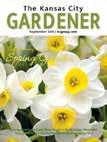
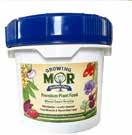


WYANDOTTE

The Kansas City Gardener | July 2023 17
COUNTY
816-380-8494; Wed, 9am-noon
Mon, Wed, Fri, 1-4pm
DOUGLAS COUNTY 785-843-7058; dgcogardenhotline@gmail.com;
MISSOURI AREA
Mon-Fri,
GREATER KANSAS CITY
816-833-8733 (TREE);
9am-noon; mggkc.hotline@gmail.com
KS
COUNTY, MO 660-747-3193; Wed, 9am-noon
COUNTY
Leave a message. A Master Gardener will contact you.
COUNTY & LINN COUNTY 913-294-4306; Thurs, 8am-noon
COUNTY,
913-715-7050; Mon-Fri, 9am-4pm; garden.help@jocogov.org JOHNSON
LEAVENWORTH
913-364-5700;
MIAMI
COUNTY
Mon, Wed, Fri, 9am-4pm
913-299-9300;
ROSES?
a Rosarian; kcrosehelp@gmail.com; www.kansascityrosesociety.org Extension Master Gardeners are ready to answer your gardening questions. Hotlines for Gardeners www.arnoldsgreenhouse.com info@arnoldsgreenhouse.com (620) 964-2463 • 1430 Hwy 58, LeRoy, KS 66857 Open 9a-5p Monday-Saturday, Closed Sundays Bringing glorious living color to your garden since 1977. Our 2023 Plant List is available on our our Facebook page. We hope to see you soon. Summer is Here! Follow us on Facebook for all the latest Specials and Deals! Your Gard en Source en 816-483-0908 | missouriorganic.com Raised Beds ~ Backyard Gardens ~ Landscaping Top Soils • Garden Soil • Raised Bed Soil • Pulverized Top Soil • Custom Soil Mixes • Green Roof Soil Blends • Rain Garden Soil Blends Compost • NatureWiseTM • Green FrontierTM • Composted Forest Products • Composted Pine Fines Services • Sudden Gardens Consultation • Soil, Compost and Mulch Delivery and Installation Soil Amendments • Growing MOR Nutrient PackTM • Soil RestorationTM • JustCharTM Mulch • Premium I • Colored Mulches (red, brown & black) • Cedar • Hardwood Chips • Erosion Stabilization Introducing Our New Growing MOR Nutrient Pack! Nutritionally-dense premium plant food with biochar, locally-sourced trace minerals and mycorrhizae–everything your plants need to thrive all year long! You’ll find all of our quality products in bulk or bags at all of our locations. Also look for our bagged mulch at Sutherland’s Lumber. Name: Address: City, State, Zip: Phone: E-mail: Where did you pick up The Kansas City Gardener? Please enclose your check payable to The Kansas City Gardener and mail with this form to: P.O. Box 8725, Prairie Village, KS 66208 The Kansas City Gardener is published monthly Jan. through Dec. For convenient mail delivery, complete the form below and send with your check for $35.00. You will receive a oneyear subscription. SUBSCRIBE TODAY
QUESTIONS ABOUT
Ask
GARDEN CALENDAR
July list of what to do in the garden.
TURF
• Mow bluegrass and tall fescue at 3 to 3 1/2 inches.
• Mow Zoysia at 1 1/2 inches.
• Fertilize Zoysia to encourage summer growth with a high-nitrogen fertilizer.
• Let grass clippings fall to return nutrients to the soil.
• Look for summer diseases such as brown patches; treat as needed.
• Sharpen mower blades for a clean cut.
• Replace the lawn mower air filter and change the lawn mower oil per owner’s manual.
• Prepare to control perennial grassy weeds such as crabgrass, fescue, and nimblewill.
• Take a soil test to prepare for fall lawn renovation.
• Water deeply and less often for deep roots and a healthy lawn.
FLOWERS
• Remove faded flowers from annuals to stimulate more buds for late summer color.
• Deadhead perennials to prevent seeding and encourage plant growth.
• Replenish mulch layers; 2 to 3 inches deep is ideal.
• Cut fresh bouquets for enjoyment.
• Lightly fertilize annuals monthly for best flowering.
• Dig, divide, and replant crowded irises.
• Dig, divide, and replant daylilies.
• Fertilize roses for fall blossoms.
• Fertilize and water container gardens.
• Complete the final pinching of chrysanthemum tips for bushier plants.

TREES AND SHRUBS
• Water newly planted shrubs and young trees (planted within the last three to five years) during dry weather.
• Keep plants mulched to conserve moisture and cool roots.
• Remove sucker growth from the base of trees and along branches.
• Prune diseased, dead, or hazardous limbs.
VEGETABLES AND FRUITS
• Harvest fruits of your labor and enjoy.
• Control weeds’ growth to preserve water and nutrients.
MY GARDEN (Use this space to list additional tasks to accomplish in your garden.)
•
•
•
•
• Fertilize vegetables to encourage plant development.
• Watch for foliar disease development on lower tomato leaves and treat with a fungicide.
• Prepare for fall gardening. Plant potatoes, broccoli, and other fall crops.
• Spray sweet corn to control corn earworms as silks emerge.
• Be on the lookout for pests in the garden and control.
• Remove old raspberry canes after harvest.
MISCELLANEOUS
• Keep compost pile moist for fast processing and turn occasionally.
• Take photographs of the garden to document success and for future planning.
Johnson County K-State Research and Extension recommends environmentally-friendly gardening practices. This starts by identifying and monitoring problems. Cultural practices and controls are the best approach for a healthy garden. If needed, use physical, biological or chemical controls. Always consider the least toxic approach first. Dennis Patton is the horticulture agent for Johnson County K-State Research and Extension. For free information fact sheets, visit www.johnson.ksu.edu, or call the Extension office at 913-715-7000.

18 July 2023 | kcgmag.com
Garden beds are located at CDD Administrative building 9150 East 41st Terrace, Kansas City, MO back of the building by PALS University



If you are interested in helping, send an email to volunteer@cddkc.org, and mention garden beds.








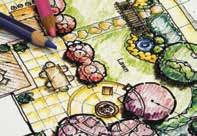


The Kansas City Gardener | July 2023 19 Planters Seed Co. • Since 1924 • Retail • Wholesale Lawn • Garden • Farm 513 Walnut, KCMO • 816-842-3651 Mon-Sat 8am-5pm, Sun 9am-3pm July Planting Dates Plant Above-Ground Crops: 17, 18, 24-27, 30, 31 • Plant Root Crops: 3, 4, 7, 8 Transplant: 25-27, 30, 31 • Plant Flowers: 17, 18, 24, 25 • Control Plant Pests: 9, 10, 14, 15 Grass Seeds • Fertilizers • Mulches • Bulbs • Bird Supplies • Pottery Best Quality of “Locally Grown” Bird Seed! Flowers & Vegetable Seed ~ Largest Selection in the Area Large selection of flower & vegetable seeds 1/2 off 7130 Troost, Kansas City, Mo. www.soilservice.com 816-444-3403 Landscape Design, Installation and Maintenance Services From trees and shrubs to perennials, mulch and stone, expert Landscape Designers are ready to help with your next project! Call today for an At-Home Consultation. AQUATIC PLANTS MARGINALS, LILIES, AND LOTUS POND AND LAKE MANAGEMENT PRODUCTS DIY POND SUPPLIES PUMPS, LINER, AND MORE GOLDFISH AND KOI PLEASE CALL TO CONFIRM PLANT AND FISH AVAILABILITY Serving the Kansas City Metro Area for 30 Years 913-837-3510 FOLLOW US 4385 W. 247TH ST., LOUISBURG, KS 66053 WWW.SWANSWATERGARDENS.COM SERVICES • POND AND WATER FEATURE INSTALLATION • SERVICE CALLS: LEAK DIAGNOSIS, LIGHTING, PUMP AND AERATION INSTALL • LANDSCAPE LIGHTING: AMP LIFETIME FIXTURES AND TRANSFORMERS • HARDSCAPES: PATIOS, WALLS, FIREPITS, DECKS, AND OUTDOOR LIVING • CLEANOUT AND MAINTENANCE PROGRAMS
Bold with Being
Boulders
No matter your budget, adding natural stone to your outdoor space is a great way to help set the scene. Our inventory ranges from boulders to pebbles. Stop in to see our great selection.

Where’s Your
Garden Flair?
Bring a little whimsy, sophistication, or affirmation to your garden with a piece of statuary. From cute bunnies to traditional buddahs, artfully stylized pets to fantastical dragons, antique cars to jumbo sports gear— we have something for every taste.

And yes, we still have gnomes.
Wildlife at the Forefront(yard)
Instead of buying lunch for yourself, treat “our locals” to lunch now... and for years to come. It’s not too late to plant a flowering perennial (for as little as $8.99) or to replace an annual for less than you’d spend at a coffee shop.

20 July 2023 | kcgmag.com
1 qt annuals starting at $5.49 1 gal perennials starting at $8.99 Hemmingway Cat (16” tall) $176.99
suburbanlg.com K-7 & Prairie Star Pkwy (913) 897-5100 135th & Wornall (816) 942-2921 105th & Roe (913) 649-8700
















































































































